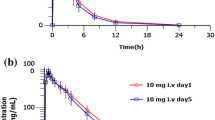Abstract
Objective
To compare antisecretory effects of single doses of rabeprazole and esomeprazole.
Methods
Open, randomised, 2-way crossover, clinical pharmacology study. 24 healthy subjects (10 men; mean age 26.2 y) received a single dose of rabeprazole 20 mg or esomeprazole 40 mg, with a 14-day ‘washout’. Intragastric pH was recorded continuously from 24 h before to 24 h after dosing.
Results
Mean intragastric pH was higher after esomeprazole than rabeprazole during 0–5 h after dosing (P=0.0001); the reverse was true from 14–24 h (P=0.0002). Mean % time pH>3 and >4 was greater after esomeprazole than rabeprazole during 0–14 h (P=0.041 and 0.044), but the reverse was true during 14–24 h (P=0.0005 and 0.001). In the 0–24 h interval as a whole, there was no difference between treatments in mean pH or % time pH>3 or >4.
Conclusion
Single-dose rabeprazole 20 mg was as effective as esomeprazole 40 mg in increasing intragastric pH and maintaining pH>3 and >4, despite the 2-fold difference in dose.


Similar content being viewed by others
References
Jones DB, Howden CW, Burget DW, Kerr GD, Hunt RH (1987) Acid suppression in duodenal ulcer: a meta-analysis to define optimal dosing with antisecretory drugs. Gut 28:1120–1127
Burget DW, Chiverton SG, Hunt RH (1990) Is there an optimal degree of acid suppression for healing of duodenal ulcers? A model of the relationship between ulcer healing and acid suppression. Gastroenterology 99:345–351
Bell NJ, Burget D, Howden CW, Wilkinson J, Hunt RH (1992) Appropriate acid suppression for the management of gastro-oesophageal reflux disease. Digestion 51(Suppl 1):59–67
Hunt RH (1995) The relationship between the control of pH and healing and symptom relief in gastro-oesophageal reflux disease. Aliment Pharmacol Ther 9(Suppl 1):3–7
Savarino V, Mela GS, Zentilin P, Mele MR, Vigneri S, Termini R, Di Mario F, Ferrana M, Malesci A, Belicchi M (1995) Once-daily bedtime dose of roxatidine and ranitidine in acute duodenal ulcer: a combined assessment of acid inhibitory activity and healing rate. Am J Ther 2:949–953
Robinson M (2004) Review article: the pharmacodynamics and pharmacokinetics of proton pump inhibitors - overview and clinical implications. Aliment Pharmacol Ther 20(Suppl 6):1–10
Gardner JD, Perdomo C, Sloan S, Hahne WF, Barth JA, Rodriguez-Stanley S, Robinson M (2002) Integrated acidity and rabeprazole pharmacology. Aliment Pharmacol Ther 16:455–464
Warrington S, Baisley K, Boyce M, Tejura B, Morocutti A, Miller N (2002) Effects of rabeprazole, 20 mg, or esomeprazole, 20 mg, on 24-h intragastric pH and serum gastrin in healthy subjects. Aliment Pharmacol Ther 16:1301–1307
Pantoflickova D, Dorta G, Ravic M, Jornod P, Blum AL (2003) Acid inhibition on the first day of dosing: comparison of four proton pump inhibitors. Aliment Pharmacol Ther 17:1507–1514
Lind T, Havelund T, Lundell L, Glise H, Lauritsen K, Pedersen SA, Anker-Hansen O, Stubberod A, Eriksson G, Carlsson R, Junghard O (1999) On demand therapy with omeprazole for the long-term management of patients with heartburn without oesophagitis - a placebo-controlled randomised trial. Aliment Pharmacol Ther 13:907–914
Talley NJ, Venables TL, Green JRB, Armstrong D, O’Kane KPJ, Giaffer M, Bardhan KD, Carlsson RGS, Chen S, Hasselgren GS (2002) Esomeprazole 40 mg and 20 mg is efficacious in the long-term management of patients with endoscopy-negative gastro-oesophageal reflux disease: a placebo-controlled trial of on-demand therapy for 6 months. Eur J Gastroenterol Hepatol 14:857–863
Bytzer P, Blum A, De Herdt D, Dubois D; The Trial Investigators (2004) Six-month trial of on-demand rabeprazole 10 mg maintains symptom relief in patients with non-erosive reflux disease. Aliment Pharmacol Ther 20:181–188
Baisley KJ, Tejura B, Morocutti A, Miller NM, Warrington SJ (2001) Rabeprazole 10 mg is equivalent to esomeprazole 20 mg in control of gastric pH in healthy volunteers. Am J Gastroenterol 96(Suppl):S48
Rohss K, Lind T, Wilder-Smith C (2004) Esomeprazole 40 mg provides more effective intragastric acid control than lansoprazole 30 mg, omeprazole 20 mg, pantoprazole 40 mg and rabeprazole 20 mg in patients with gastro-oesophageal reflux symptoms. Eur J Clin Pharmacol 60:531–539
Williams MP, Sercombe J, Hamilton MI, Pounder RE (1998) A placebo-controlled trial to assess the effects of 8 days of dosing with rabeprazole versus omeprazole on 24-h intragastric acidity and serum gastrin concentrations in young healthy male subjects. Aliment Pharmacol Ther 12:1079–1089
Bruley des Varannes S, Gharib H, Bicheler V, Bost R, Bonaz B, Stanescu L, Delchier JC, Bonnot-Marlier S (2004) Effect of low-dose rabeprazole and omeprazole on gastric acidity: results of a double blind, randomized, placebo-controlled, three-way crossover study in healthy subjects. Aliment Pharmacol Ther 20:899–907
Morozov SV, Tsodikova OM, Isakov VA, Gushchin AE, Shipulin GA (2003) Comparative effectiveness of the antisecretory action of rabeprazole and esomeprazole in people with rapid metabolism of proton pump inhibitors. Eksp Klin Gastroenterol 6:58–63 [in Russian]
Besancon M, Simon A, Sachs G, Shin JM (1997) Sites of reaction of the gastric H,K-ATPase with extracytoplasmic thiol reagents. J Biol Chem 272:22438–22446
Kromer W, Kruger U, Huber R, Hartmann M, Steinijans VW (1998) Differences in pH-dependent activation rates of substituted benzimidazoles and biological in vitro correlates. Pharmacology 56:57–70
Richardson P, Hawkey CJ, Stack WA (1998) Proton pump inhibitors. Pharmacology and rationale for use in gastrointestinal disorders. Drugs 56:307–335
Horn J (2000) The proton-pump inhibitors: similarities and differences. Clin Ther 22:266–280
Horn J (2004) Review article: relationship between the metabolism and efficacy of proton pump inhibitors-focus on rabeprazole. Aliment Pharmacol Ther 20(Suppl 6):11–19
Author information
Authors and Affiliations
Corresponding author
Additional information
Supported by Eisai Ltd., London, UK
Rights and permissions
About this article
Cite this article
Warrington, S., Baisley, K., Dunn, K. et al. Effects of single doses of rabeprazole 20 mg and esomeprazole 40 mg on 24-h intragastric pH in healthy subjects. Eur J Clin Pharmacol 62, 685–691 (2006). https://doi.org/10.1007/s00228-006-0148-5
Received:
Accepted:
Published:
Issue Date:
DOI: https://doi.org/10.1007/s00228-006-0148-5




